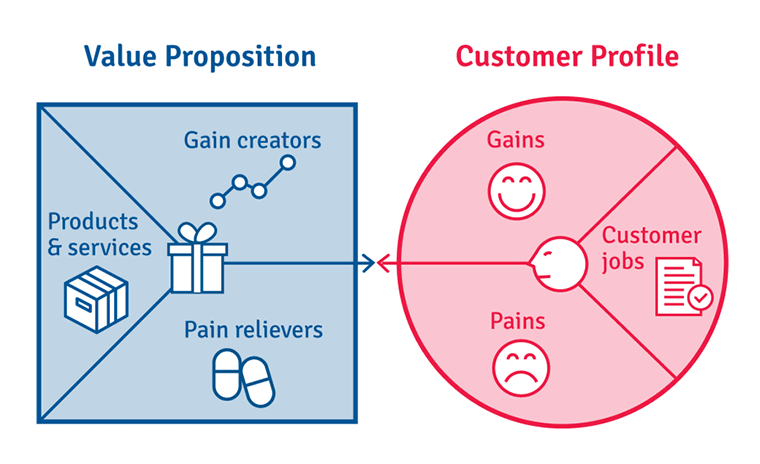Every entrepreneur knows how to draw out the business model canvas on a whiteboard. Why? Because it's a critical for business success. It forces you to establish the core of the venture and figure out what levers you need to pull to make it a go.
But the canvas isn't a tool just for entrepreneurs or startups. In fact, we believe marketers should be intimately familiar with the business model canvas -- and more specifically, the value proposition canvas.
So, what exactly is it?
Part of Dr. Alexander Osterwalder’s broader (and quite popular) Business Model Canvas, the value proposition canvas is typically used to help new(er) businesses find their product-market fit as they create or refine a value proposition.
However, the value proposition canvas is more than a one-time exercise. It's far more valuable than that.
The business model canvas can help the marketing team review the current value proposition, embark on a new campaign, identify new actionable insights and areas for growth, and even double down on the specific pains or motivations that are tied to your product or service.
Here's a quick glance at the canvas:

As you can see, the simplicity of this diagram makes it easy to draw on a whiteboard or sketch on a piece of paper during a marketing meeting. The value proposition canvas is composed of two parts:
- The customer profile
- The value map
The two are separate, but strategically intersect to bring -- you guessed it -- value. The intersection of the value proposition and the customer profile is where the magic happens.
Marketing Exercise #1: Building Your Customer Profile
If you're a damn good marketer, chances are, you've already done this step. But as we've discovered, doing something once (especially when it comes to research) doesn't mean it's done. Customer development and research is an ongoing endeavor.
For the purposes of the value proposition canvas, we encourage you to go through this again from start to finish as key insights have a way of emerging when you're not looking for them.
As displayed in the diagram, the customer profile has three parts:
- Jobs
- Gains
- Pains of a consumer
However, it's not as easy as simply putting stuff in boxes. Let's examine how to break down each of the boxes and the strategic way to think about this information.
Step 1: Think differently about the jobs of your customers
Jobs-to-be-done (JBTD) is a popular methodology when it comes to innovation - but it can be applied to the customer journey and provide powerful insights for marketing.
Developed by Clayton Christensen at Harvard Business School Harvard Business Review, JTBD thinking transforms our understanding of customer choice in a way that no amount of data ever could. In fact, according to this article, the word "job" is is shorthand for what an individual really seeks to accomplish in a given circumstance.
We couldn't agree more.
The jobs section of the value proposition canvas includes the problems your customers need to solve, the needs they have, and the tasks they look to accomplish.
Hint: This is illustrated by the popular phrase "people don't want a drill bit, they want a 1/4" hole".
These jobs fall into a few different categories:
- Social jobs: how an individual wants to be perceived by others (trying to look good, gain friends or status)
- Emotional jobs: wanting to feel a specific feeling (feeling good or feeling accomplished)
- Functional jobs: fulfilling a specific task or a project
- Supporting jobs: any additional jobs that are necessary to accomplish their main goal
Taking time to list the jobs a customer wants to accomplish both humanizes them and adds a deeper layer to your knowledge about their motivations. Rather than focusing solely on the actions they take, it helps your team to see why they might take those specific actions.
Team Exercise: Take 5 minutes and have each member of your team list the jobs they believe a specific customer persona has.

Step 2: Explore customer pains
What struggles or challenges do your customers face as they look to get their jobs done?
This could be frustrations with the process, their current solutions, or unknown barriers. What keeps your customers awake at night? Without tapping into the challenges they face, it can be difficult to know the value that your company can bring.
As a marketer, it's important to think through this, but it's also important to get input from the sales team, the operations team, the customer service teams, and new employees.
For example, a sales team member may discover that all of the prospects he talks to want to be able to buy the product through a distributor because they don't plan ahead very well to stock inventory. What matters more to him is being able to buy it on a moments notice, not to learn how to plan better.
Team Exercise: List out all of the pain points for your customer and rank them by intensity.
Step 3: Discover customer gains
Customer gains are the things that a customer gets excited about as they try to accomplish their goals and get their job done. What would surprise them and make their lives easier? Compile a list of the things that would make them return to a specific product or service.
- Required gains: what are the basic needs your customers have when it comes to a potential solution?
- Expected gains: what do your customers expect from their solution?
- Desired gains: what do your customers hope to get from the solution but don’t necessarily expect?
- Unexpected gains: what would amaze your customer and make their day?
A couple of examples of this might be:
- Thinking about how you could exceed customer expectations. What's the minimum viable dose of effort, and how can you blow that out of the water?
- Pondering a feature in your product or service that would get customers talking about it without prompting. What would be worth "talking about"?
- Brainstorming improvements to a current solution that would delight your customers. What part of your product or service only "kinda" solves a problem, but doesn't really go the whole way?
If you're looking for more questions to use with your team, refer to the bulleted list at the bottom of this thread over at Strategyzer.
Team Exercise: Focus on the unexpected gains. What would it take to “wow” your customers? Make a list and order them by how realistic they are.
Marketing Exercise #2: Draw Your Value Map
Once you've got the customer profile down (and the drawing to accompany it), it's time to shift gears to analyze your product or service. Start with the features.
Step 1: List product & service features
This is an all-encompassing list of the product and service features that help your customers get their jobs done, overcome their pain, and meet their expectations. Your list should include everything from essential product features to small, side benefits that could impact your customer.
For example, if you have a software product, some side benefits might include team collaboration functionality, offline capabilities, or a great mobile experience!
Team Exercise: Think outside the box. Features that might seem normal to you might be a game-changer for your customers!
Step 2: Outline gain creators
Gain creators show the value that your product can bring to your customers, outlining the specific benefits a customer can expect. How do your products or services make customers happy or help them fulfill their dreams?
These gains cover everything from basic customer expectations being fulfilled (like a working product) to going above and beyond customers’ imaginations. Gain creators include:
- Functional utility
- Social gains
- Positive emotions
- Cost savings
Team Exercise: Make a list of ways that your product or service meets or exceeds customer expectations. Rank them from essential gains to nice-to-haves.
When it comes to gain creators vs pain relievers, we invite you to think about whether your company is a pain killer or a vitamin. The emotions associated with each are very powerful, but very different. The answer should be clear as you work through these two areas!
Step 3: Brainstorm pain relievers
Reflect on the pain points that your customers have as they look to accomplish their goals. Then make a list of the ways that your product or service eliminates those problems.
As you look to determine these pain relievers, ask these questions:
- What frustrations do we help our customers overcome?
- What risks can they avoid with our help?
- How do we help our customers sleep better at night? Or save them from a headache?
Team Exercise: Think back on interactions with real customers, if possible. What relief did your product or service give them? Make a list and rank them by importance to your customers.
Putting The Canvas to Work with Your Team
While this is the "marketers guide" to the value proposition canvas, the thing that makes it valuable is taking it outside of the marketing department.
It's essential that marketers take the time to constantly communicate with customers and deepen their understanding of their needs and priorities.
However, in today's modern marketing team, it's critical that the information is shared across teams, departments, and leaders. Actionable insights should be something that everyone can tap i into, from product development to sales to HR.
Invest in these exercises and encourage your team to dig into the motivations of your customers—and the ways that your product or service can help them accomplish their goals.
It might mean adjusting your value proposition. Or it might just mean you’re more knowledgeable as you carry out your marketing campaigns.
So grab a big pack of sticky notes and get started! The value proposition canvas is a great way to pinpoint the ways you serve your customers and help them achieve their goals.

